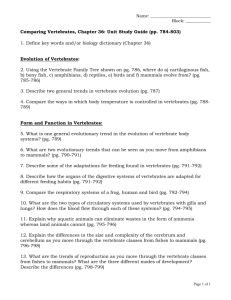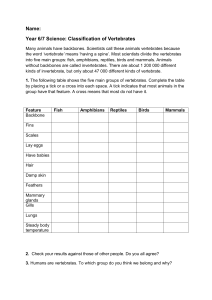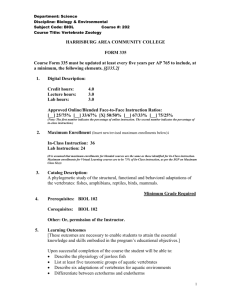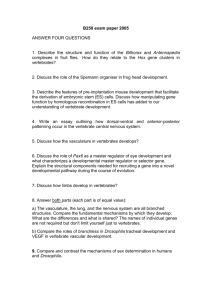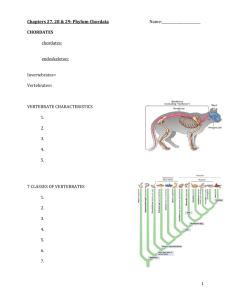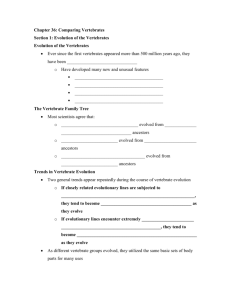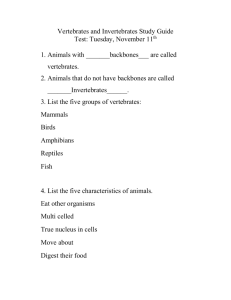Exam #3
advertisement
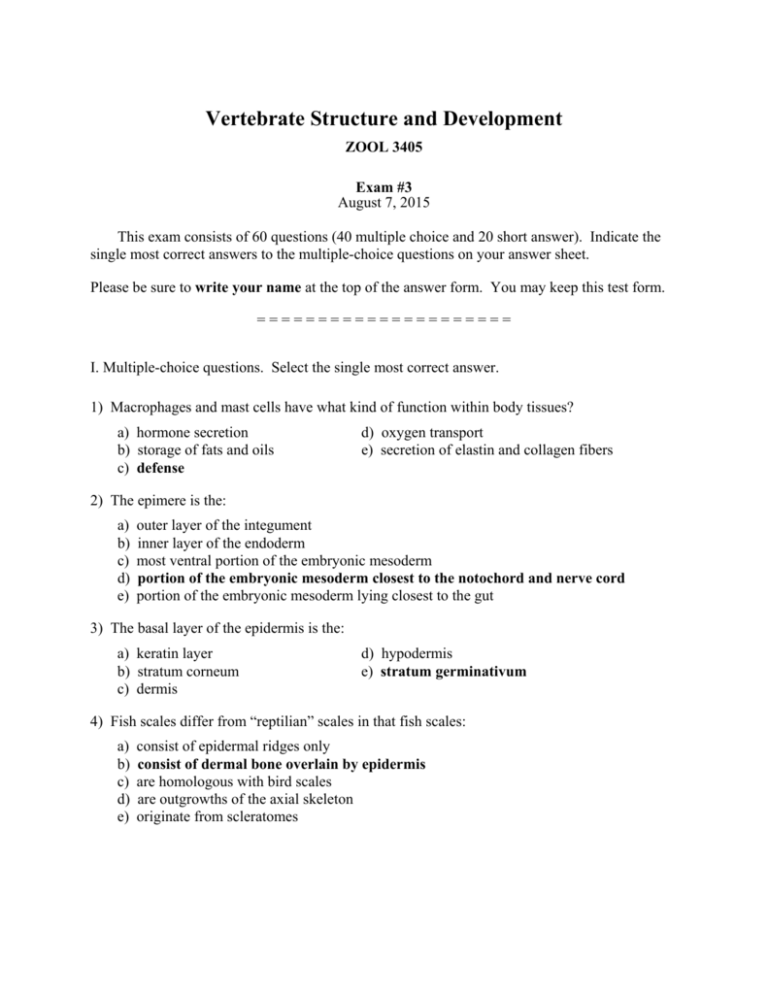
Vertebrate Structure and Development ZOOL 3405 Exam #3 August 7, 2015 This exam consists of 60 questions (40 multiple choice and 20 short answer). Indicate the single most correct answers to the multiple-choice questions on your answer sheet. Please be sure to write your name at the top of the answer form. You may keep this test form. ===================== I. Multiple-choice questions. Select the single most correct answer. 1) Macrophages and mast cells have what kind of function within body tissues? a) hormone secretion b) storage of fats and oils c) defense d) oxygen transport e) secretion of elastin and collagen fibers 2) The epimere is the: a) b) c) d) e) outer layer of the integument inner layer of the endoderm most ventral portion of the embryonic mesoderm portion of the embryonic mesoderm closest to the notochord and nerve cord portion of the embryonic mesoderm lying closest to the gut 3) The basal layer of the epidermis is the: a) keratin layer b) stratum corneum c) dermis d) hypodermis e) stratum germinativum 4) Fish scales differ from “reptilian” scales in that fish scales: a) b) c) d) e) consist of epidermal ridges only consist of dermal bone overlain by epidermis are homologous with bird scales are outgrowths of the axial skeleton originate from scleratomes 2 5) Which of the following structures originate from mesodermal tissue only? a) hair follicles b) intestinal tract c) eye lens d) human skin e) heart 6) Which of the following would not be a function of the mucous coating on the skin of a freshwater fish? a) b) c) d) e) reducing salt loss from the body increasing swimming efficiency “sloughing off” particulate matter reducing water loss from the body offering some protection from predators 7) Carotenoids and pterins are: a) b) c) d) e) neurotransmitters plant pigments sequestered by chromatophores hormones involved in osmoregulation hormones secreted by the pancreas proteins involved in bioluminescence 8) The exchange of gases across an epithelial surface: a) is more efficient when the blood is moving quickly b) is by means of active transport of gas molecules c) results from diffusion from a high-concentration medium to a low-concentration medium d) occurs only in gills or lungs e) can occur across either wet or dry surfaces 9) The nasal cavity is connected to the buccal cavity in all of the following groups except: a) amphibians b) lungfishes c) mammals d) birds e) bony fishes 10) Which of the following structures develops primarily from ectoderm? a) brain and spinal cord b) intestinal tract c) pancreas d) heart e) vertebral column 11) The possession of a camouflaging color pattern is called: a) bioluminencence b) apomixis c) warning coloration d) osmoregulation e) crypsis 3 12) Electrical organs: a) b) c) d) e) are found in all fishes and amphibians are homologous in all organisms in which they occur are used primarily to stun potential prey are more common in amphibians than in fishes consist of modified myofibers 13) Actin and myosin: a) are found only in vertebrates b) are active in skeletal, smooth, and cardiac muscle c) are the only proteins involved in muscular contraction d) are found only in striated muscle e) contribute to bone formation 14) The oldest known vertebrate fossils having feathers were: a) dinosaurs b) amphibians c) pterosaurs d) mammals e) birds 15) Luciferin and luciferase are: a) components of smooth muscle d) proteins involved in muscle contraction b) components of the dermis e) hormones c) proteins involved in light production 16) A synapse: a) b) c) d) e) is a physical connection between the membranes of two neurons ensures unidirectional flow of nerve impulses passes electrical impulses primarily from dendrites to axon works by means of very long-lived neurotransmitter molecules encases the axon within a sheath of myelin 17) Olfactory receptors differ from taste buds (gustatory receptors) in that olfactory receptors: a) b) c) d) e) are found only in mammals are located only on the tongue in vertebrates primarily detect water-soluble chemicals primarily detect fat-soluble chemicals are tertiary receptors 18) Sensory receptors located within muscles, tendons, and joints: a) labyrinth organs b) proprioceptors c) chemoreceptors d) radioreceptors e) pit organs 4 19) The idea that the heart is the center of love and emotion probably results from the fact that: a) b) c) d) e) the iron in hemoglobin produces a red color it is innervated by the autonomic nervous system cardiac muscle is intrinsically contractile we can feel the rhythmic pulsing of the aortic arch the body dies when the heart stops beating 20) Which of the following structures do not develop from somites? a) branchiomeric muscles b) myomeres c) vertebrae d) dermatomes e) hypobranchial muscles 21) Some sharks can undergo long migrations, following the magnetic field of the earth by means of their: a) neuromasts b) ampullae of Lorenzini c) pineal glands d) chemoreceptors e) olfactory receptors 22) Pharyngeal pouches: a) b) c) d) e) have hemibranchs on their anterior and posterior sides are external in larval fishes and amphibians produce gills in vertebrate embryos occur in all vertebrates at some stage of development develop into lungs in terrestrial vertebrates 23) Which kind of structure would not be found in the dermis? a) nerves b) chromatophores c) keratinized epithelium d) adipose cells e) capillaries 24) A rete is a general term for a: a) b) c) d) e) cluster of cell bodies within the brain blood-pressure sensor cluster of nerve endings within a tendon countercurrent network within the circulatory system mass of lymphatic vessels 25) The timing of circadian and monthly cycles is strongly influenced by hormonal secretions of the: a) optic tectum b) cerebral hemispheres c) pineal body d) adenohypophysis e) metencephalon 5 26) Which of the following structures are not composed of smooth muscle? a) intrinsic eyeball muscles b) hair erector muscles c) intestinal wall muscles d) feather erector muscles e) mimetic muscles 27) The secondary circulatory system that returns ‘leaked’ fluids to the blood-vascular system: a) hepatic portal b) pulmonary c) afferent d) lymphatic e) systematic 28) The optic vesicle, an outgrowth of the brain, stimulates the development of the lens and cornea by a process called: a) induction b) gastrulation c) enterocoely d) cleavage e) differentiation 29) The limbic system in humans is primarily: a) b) c) d) e) an olfactory center a switchboard for visual functions a brain region in which locomotory movements are generated and controlled a brain region linking emotions to basic physiological processes a center for the control of respiratory functions 30) The basic function of the utriculus and sacculus of the labyrinth organ is to enable the organism to: a) b) c) d) e) keep track of the position of the endolymphatic fluid in the semicircular canals maintain a constant direction of motion of the body sense pressure waves moving along the body determine the position of the body with respect to gravity sense the position of potential predators or prey nearby 31) Which of the following is not a component of the acoustico-lateralis system of a fish or amphibian? a) endolymphatic fluid b) neuromast c) lagena d) semicircular canals e) auditory ossicles 32) The region (lobe or vesicle) of the brain that is primitively associated with olfaction is the: a) telencephalon b) diencephalon c) metencephalon d) mesencephalon e) prosencephalon 6 33) The derived portion of the labyrinth in mammals that greatly increases hearing sensitivity: a) cristae b) utriculus c) cochlea d) sacculus e) otoliths 34) Secondary receptors able to detect heat and cold are located in the: a) epidermis b) wall of the digestive tract c) skeletal muscles d) stratum corneum e) dermis 35) The inner-ear function that is common to all vertebrates: a) b) c) d) e) detection of low-frequency pressure waves electromagnetic reception orientation and equilibrium detection of high-frequency pressure waves hearing 36) Which is not true about dorsal medial eyes? a) b) c) d) e) they are associated with circadian rhythms they form focused images two develop in embryos, but at most one is functional in adults they are absent in most living adult vertebrates they are derived from the roof of the diencephalon 37) Portal systems: a) are large blood cavities not lined by endothelium b) always receive venous blood c) have arisen independently in a number of vertebrate groups d) serve as blood filters e) always receive arterial blood 38) In tetrapods, the intrinsic eye muscles attached to the lens originate on the: a) ciliary body b) retina c) cornea d) sclera e) choroid layer 39) Terrestrial vertebrates control the focus of the image on the retina by changing: a) b) c) d) e) the shape of the retina the amount of light entering the eye the distance between the lens and the retina the shape of the lens the kinds of radioreceptors with which light is detected 7 40) The group of living mammals that is characterized by many “reptilian” traits (e.g., scales, cleidoic eggs, heterothermic body temperature): a) marsupials b) monotremes c) metatherians d) placentals e) eutherians II. Short answer questions. Provide the terms (words or phrases) for which the following are definitions. Give terms, not examples. 41) Neurohypophysis, hypothalamus, infundibulum The portion of the brain that forms the dorsal (posterior, in humans) portion of the pituitary gland. 42) Endothelium The epithelial tissue layer that provides an inner lining for most of the circulatory system. 43) Cones The sensory cells within the retina that are sensitive to bright light and color. 44) Natural selection An evolutionary model accounting for adaptation of populations to their environments due to differences in fitness among organisms. 45) Coelom The embryonic cavity that is surrounded by mesodermal cells and does not open to the outside of the body. 46) Cleidoic The type of egg that is characteristic of reptiles (including birds) and mammals. 47) Leucocytes The blood cells that are specialized for protection against foreign cells and substances within the blood-vascular system. 48) Sebum A complex mixture of hydrophobic oils and waxes that is secreted within feather and hair follicles by birds and mammals. 49) Tympanic/angular, malleus/articular, incus/quadrate, stapes/hyomandibular 50) Diencephalon The name of one of the auditory ossicles of mammals, along with the corresponding ancestral jaw bone with which it is homologous. The major region (lobe or vesicle) of the adult brain that is differentiated into several different structures that secrete hormones. 8 51) Optic tectum The thickened dorsal surface of the mesencephalon that serves as a visual center in lower vertebrates and a secondary visual center in higher vertebrates. 52) Glial, neuroglial Cells that support, nourish, and interact with neurons within the central nervous system. 53) Pleural The coelomic cavity within which the lungs lie. 54) Dentin A very hard, calcareous, dermal secretion that may coat scales and teeth. 55) Neurotransmitters The general name for chemicals that are produced by neurons and that serve to conduct nerve impulses from one cell to another. 56) Metencephalon The name of the lobe or vesicle of the adult vertebrate brain in which the cerebellum is located. 57) Myelin sheath The wrapping of fatty connective tissue that surrounds and insulates an axon. 58) Neural crest The tissue that is most important in inducing the major structures of the head and peripheral nervous system in vertebrates. 59) Somites The longitudinally subdivided segments of mesoderm that give rise to all of the structures of the vertebrate body associated with body segmentation. 60) Peristalsis Waves of muscular contraction (of smooth or cardiac muscle) that move fluids or solids through tubes.
